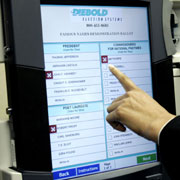Tuesday, May 30, 2006
Electronic Voting Vulnerabilities Actually Noted By MSM

The possibility of electronic voting skullduggery is one of those subjects that cannot be raised in polite company in Washington.
Given the reticence to bring up this touchy issue, a not terribly probing article in today's Washington Post is noteworthy for simply breaking the taboo.
A coalition of voting rights activists and prominent computer scientists argues that some of the machines are not sufficiently secure against tampering and could result in disputed elections, while voting machine vendors and many election officials say that view is exaggerated.
The latest dispute occurred several weeks ago after it was discovered at a test in Utah that someone with a reasonable knowledge of computer code could gain access to and tamper with the system software on a popular brand of voting machine manufactured by Diebold Election Systems. The developments prompted California and Pennsylvania to send urgent warnings to counties that use Diebold's touch-screen voting systems to take additional steps to secure them...
In California, David Jefferson, a computer scientist at Lawrence Livermore National Laboratory who consults with the state on its elections, said he was "stunned when he found out" about the vulnerability identified in the Utah test and agreed with the "frequently expressed opinion that this is the worst vulnerability that we have ever seen."
But Diebold spokesman David Bear said it was a "functionality" that company engineers had built into the voting machines so their software could be easily updated, and it only becomes an vulnerability if an unauthorized person gains unfettered access to the machine, and there are safeguards against that happening...
By passing the 2002 Help America Vote Act and spending more than $2 billion to upgrade voting machines nationwide, Congress hoped to avoid this kind of exchange. HAVA was a response to the contested 2000 presidential election in Florida, which had brought the use of old punch-card voting machines into focus.
The newer technology, such as touch-screen and optical scan systems, held the promise of making voting more secure, transparent and accessible. But as the new technology was implemented, voting rights activists raised questions about whether vendors had paid enough attention to security. Activists pushed for the use of technology that still provided a paper record.
Anyone interested in a more probing look at the "tamper-proof" electronic voting machines is encouraged to visit BlackBoxVoting.org.


